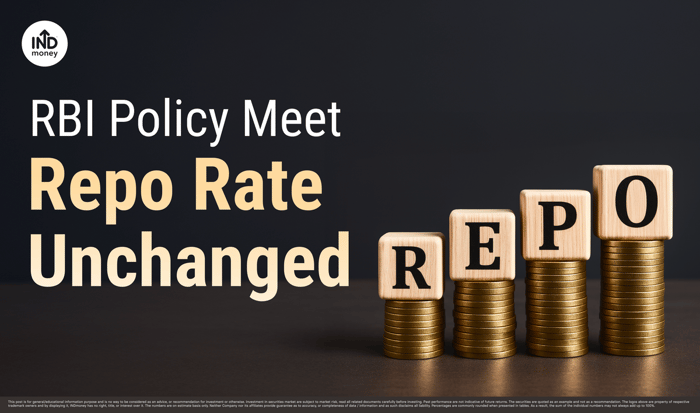
- Repo Rate Stays at 5.5% After RBI MPC Meeting
- Inflation Trends
- Growth Outlook
- Why RBI Maintained Neutral Stance in the MPC Meeting
- RBI Policy 2025: Key Banking, Credit, and Rupee Reforms
- Key Takeaways for Investors from RBI Policy
- Conclusion
- Disclaimer
The Reserve Bank of India (RBI) held its Monetary Policy Committee (MPC) meeting from September 29 to October 1, 2025. At the end of the review, the decision was to keep interest rates unchanged, even though inflation has fallen sharply and economic growth remains resilient.
Repo Rate Stays at 5.5% After RBI MPC Meeting
The policy repo rate, which is the rate at which banks borrow from the RBI, stays at 5.5%. The standing deposit facility (SDF) remains at 5.25% and the marginal standing facility (MSF) and the Bank Rate at 5.75%. The MPC also kept its stance “neutral”, meaning it has not tilted towards either raising or cutting rates.
The repo rate matters because it is the benchmark for borrowing costs across the economy. When RBI reduces this rate, banks can borrow more cheaply, which usually leads to lower EMIs for home loans, car loans, and business loans. When it raises the rate, borrowing becomes costlier and spending slows. By leaving it unchanged, RBI has chosen stability in borrowing costs.
Inflation Trends
Inflation, which is the pace at which prices rise, has declined significantly. In July 2025, headline CPI inflation touched 1.6%, before moving slightly higher to 2.1% in August. For the full financial year, RBI has revised its forecast to 2.6%, much lower than the earlier projection of 3.7% made in June.
This fall in inflation is mainly because of lower food prices. A good monsoon, strong kharif sowing, and comfortable foodgrain stocks have helped keep supplies stable. The recent rationalisation of GST rates has also lowered the prices of several items.
You can use our Inflation calculator by clicking here
For investors, low and steady inflation supports stable bond yields and provides a favourable environment for equity markets, especially in consumption-driven sectors.
Growth Outlook
India’s economy continues to show strength. In the first quarter of FY26, GDP grew 7.8%. The drivers have been private consumption, investment, and services, all supported by steady urban demand and a healthy monsoon.
Looking ahead, RBI expects growth of 6.8% for the full year. The quarterly projections are: Q2 at 7.0%, Q3 at 6.4%, and Q4 at 6.2%. For the first quarter of 2026-27, growth is projected at 6.4%.
While domestic activity is firm, there are risks. Global trade tensions, tariffs, and volatility in financial markets could weaken external demand. Foreign portfolio investors have already pulled out close to 3.9 billion US dollars so far this year. Geopolitical uncertainties also remain a concern.
Why RBI Maintained Neutral Stance in the MPC Meeting
Even with inflation at multi-year lows, RBI has chosen not to cut rates immediately. The central bank believes it is better to observe how earlier policy actions and fiscal measures are working before making new moves. In simple terms, the RBI prefers stability until external risks become clearer.
RBI Policy 2025: Key Banking, Credit, and Rupee Reforms
Apart from rate decisions, RBI announced 22 measures that aim to strengthen the financial system. Some important steps are:
- Banking reforms: New provisioning norms (ECL framework) from April 2027, revised Basel III capital rules, and risk-based deposit insurance.
- Credit flow: Higher limits for lending against shares and IPO financing, and new rules to support corporate borrowing.
- Ease of doing business: Simplification of nearly 9,000 RBI circulars, relaxation of current account rules, and extended timelines for exporters.
- Consumer protection: Digital banking services for basic savings accounts, stronger ombudsman mechanisms, and coverage of rural cooperative banks.
- Rupee internationalisation: Allowing cross-border lending in rupees to neighbours, enabling rupee balances for investment in corporate bonds, and setting transparent reference rates.
These measures may not have an immediate market impact but signal long-term positives for banks, NBFCs, infrastructure finance, and the rupee’s global role.
Key Takeaways for Investors from RBI Policy
For investors, the main takeaways from this policy are:
- Borrowing costs remain steady since the repo rate is unchanged.
- Inflation is low and predictable, which supports bond and equity markets.
- Growth is strong in domestic-driven sectors such as services, consumption, and infrastructure.
- Reforms are positive for the financial sector and for long-term currency stability.
- Global risks remain and may affect exporters and market sentiment.
Conclusion
The RBI has acted cautiously by keeping rates unchanged while inflation is low and growth is firm. For investors, this means a period of stability in interest rates, comfort from low inflation, and long-term benefits from structural reforms, even as global risks continue to shape the outlook.
Disclaimer
Investments in the securities market are subject to market risks, read all the related documents carefully before investing. The securities are quoted as an example and not as a recommendation.This is nowhere to be considered as an advice, recommendation or solicitation of offer to buy or sell or subscribe for securities. INDStocks SIP / Mini Save is a SIP feature that enables Customer(s) to save a fixed amount on a daily basis to invest in Indian Stock. INDstocks Private Limited (formerly known as INDmoney Private Limited) 616, Level 6, Suncity Success Tower, Sector 65, Gurugram, 122005, SEBI Stock Broking Registration No: INZ000305337, Trading and Clearing Member of NSE (90267, M70042) and BSE, BSE StarMF (6779), SEBI Depository Participant Reg. No. IN-DP-690-2022, Depository Participant ID: CDSL 12095500, Research Analyst Registration No. INH000018948 BSE RA Enlistment No. 6428. Refer https://indstocks.com/pricing?type=indian-stocks; https://www.indstocks.com/page/indian-stocks-sip-terms-and-condition for further details.